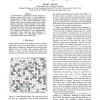Free Online Productivity Tools
i2Speak
i2Symbol
i2OCR
iTex2Img
iWeb2Print
iWeb2Shot
i2Type
iPdf2Split
iPdf2Merge
i2Bopomofo
i2Arabic
i2Style
i2Image
i2PDF
iLatex2Rtf
Sci2ools
COSIT
1997
Springer
1997
Springer
Spatial Representation for Pragmatic Navigation
As described here, pragmatic navigation attempts to harness simple facts about a two-dimensional environment to facilitate travel through it without an explicit map. It relies upon predefined spatial representations whose explicit instances are learned during a sequence of trips through a fixed maze. Once learned, any of these instances can be applied to subsequent travel. Some of the representations are heuristic, as are the procedures that employ them. The resultant performance of an implementation, particularly when contrasted with traditional AI techniques, argues for path-finding guided by representations like those detailed here.
| Added | 07 Aug 2010 |
| Updated | 07 Aug 2010 |
| Type | Conference |
| Year | 1997 |
| Where | COSIT |
| Authors | Susan L. Epstein |
Comments (0)

